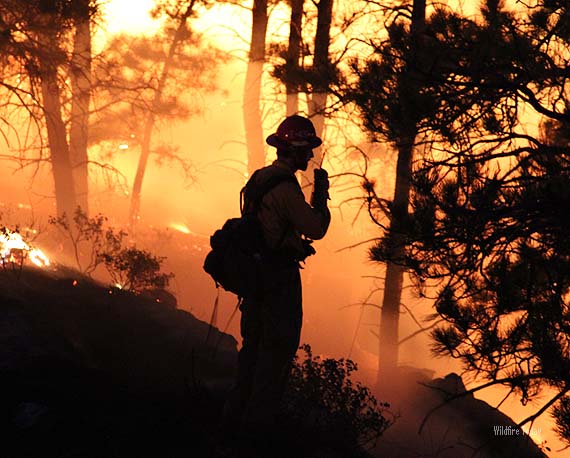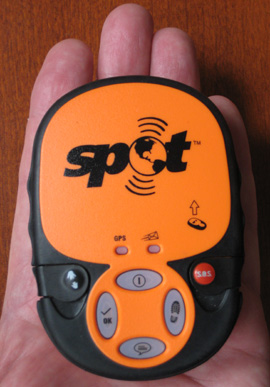It is extremely dry in much of California, southern Idaho, and Nevada.

News and opinion about wildland fire

We have written several times about how the inability of fire supervisors to always be situationally aware of the location of firefighters has contributed to at least 24 deaths in recent years — 19 on the Yarnell Hill Fire and 5 on the Esperanza fire. Last month we told you about a system the Florida Forest Service is installing in their radio systems that tracks the location of firefighters. The Orlando Sentinel has an article about this system which provides a few more details. Below is an excerpt:
…To cut through the fog and friction, the Florida Forest Service has been rolling out its Asset Tracker System, equipping all of the nearly 400 bulldozers and fire engines statewide with GPS receivers and radio transmitters. System software will be installed in the laptops of nearly 60 supervisors.
Ralph Crawford, assistant chief of forest protection, said the largely home-built system will cost nearly $2 million but won’t have major, ongoing costs because it doesn’t rely on cellphone or Internet service.
Among the first crews equipped with tracking units were those responding to the Blue Ribbon Fire. But the system was still new, and only one of the ill-fated bulldozers had a location transmitter.
Since then, the system has been refined, and its capabilities are becoming more apparent, said John Kern, a deputy chief of field operations.
Every 30 seconds, the units blurt out an electronic warble, confirming that a packet of data containing unit identification, location, speed and direction had been transmitted by a 40-watt radio able to reach supervisor laptops within 2 miles.
The system doesn’t provide a complete picture of a wildfire; the blaze, for example, isn’t outlined on maps depicted on laptop screens.
But Kern said supervisors are learning to correlate the GPS tracking data with their knowledge of tactics used when fighting fires with bulldozers. Supervisors also will know where to direct a helicopter to drop water should trouble occur.
“If one of our guys calls in, ‘I’m stuck and about to be burned over,’ we’ll know where to go,” Kerns said.
Thanks and a hat tip go out to Kraig

Investigators used GPS tracking devices to gather evidence about a former firefighter who is accused of setting several wildfires in California, including the Clover Fire that killed one resident, burned 8,073 acres, and destroyed 60 homes.
Zane Wallace has been charged with over 200 arson-related counts, including 60 for arson to occupied structures. The fires occurred in September and October of 2013 in Shasta County.
According to information uncovered by the Redding Searchlight, investigators interviewed Mr. Wallace the day after the Clover Fire started, and later placed the tracking devices on two of his vehicles, which were later recorded at the location of some of the fires that started after the GPS devices were in place.
The U.S. Forest Service confirmed that Mr. Peterson was a former employee on the Mendocino National Forest. He worked as a firefighter (Forestry Technician) and fire engine operator from May 15, 2005 until October 22, 2012.
Thanks and a hat tip go out to Dick
The U.S. Forest Service has released a “Learning Review Report” for the All Terrain Vehicle (ATV) accident on the Schoolhouse Fire in New Mexico that killed firefighter Token Adams. You may have followed the search for Mr. Adams, who was missing for a week before his body was found on September 6, 2013.
The report is very well written and appears to discuss in detail numerous issues directly and indirectly related to the accident. It does not use, like the first Yarnell Hill Fire report, dozens of the latest in-vogue buzz words that are in fashion this week in the human behavior community. (It only uses a few.) The report covers real issues that firefighters, and especially firefighters who operate ATVs, can relate to.
It does not place blame on anyone, and from the evidence presented, this seems appropriate, in that no one really made any serious mistakes that would normally have been avoided. All of the required personal protective equipment, training, and qualifications were in place.
The accident occurred as Mr. Token was searching for a reported fire on an ATV, as he attempted to go up a short 30 percent grade, a slope easily traversed on an ATV. A tire slipped on a rock that may have been partially hidden by pine needles, causing the center of gravity to shift. The ATV began to roll, causing Mr. Token to either jump or fall off. The ATV rolled over Mr. Token, hit a tree and then settled back on him. The rear cargo rack landed on his neck, impacting just below his full-face helmet, and he died instantly.
The video below uses some surprising techniques to illustrate how the accident occurred.
Two items listed in the lessons learned analysis generated further discussion in the report:
ATV safety culture
In the course of the search, line officers spent a lot of time in the field with employees talking about the use of ATVs in the Forest Service. The employees shared their experiences concerning close calls and minor accidents involving ATVs which had not been reported. Several of these instances were shocking to the line officers. who had no experience on ATVs. The employees thought that if these numerous incidents had been reported the agency would have banned ATVs, which were thought to be extremely useful in accomplishing their jobs. After these revelations, the line officers were stunned, and not sure what the Lesson should be. They didn’t want to make an uninformed knee-jerk decision, and felt the need to obtain a deeper understanding of ATV risks.
I can understand this culture completely. While scouting a very large planned prescribed fire on an ATV, it rolled 90 degrees. I stepped off, uninjured, as it ended up on its side. I pushed the undamaged ATV back onto its tires, started it up and continued evaluating the prescribed fire. Of course I did not report it to anyone, including the other person traveling ahead of me on another ATV.
There are probably hundreds of similar non-injury unreported ATV mishaps that occur every year in land management agencies.
Location reporting devices

While radios and cell phones can be very useful in most cases to call for help in the case of an accident, there are times when an employee is in an area where there is no reception. Or, as in the case of this ATV accident, the victim is incapacitated and can’t make a call. While a real-time automatic location tracking device would not have saved Mr. Adams, since he died instantly, it would have made a difference to the 200+ searchers and his family who spent a week looking for him.
In 2012 we wrote about the USFS’ solicitation to buy $1.2 million worth of Satellite Emergency Notification Devices (SEND). The agency purchased 6,000 of them. This is not enough for every employee, and one was not used by Mr. Token that day. These hand-held consumer-quality devices are better than nothing, but it is a very unprofessional attempt to enhance the safety of field personnel. We can do better.
I have written before about how the inability of fire supervisors to always be situationally aware of the location of firefighters has contributed to at least 24 deaths in recent years — 19 on the Yarnell Hill Fire and 5 on the Esperanza fire.
The Holy Grail of Firefighter Safety, as I envision it, would enable firefighters’ radios to transmit their location in real time which would then show up on a remote display (on anything from a cell phone or a 7″ tablet, up to a laptop or desktop computer) that would be monitored by a dispatcher, Safety Officer, Branch Director, Operations Section Chief, Branch Director, or Division Supervisor. The display would also show the real time location of the fire. Knowing either of these in real time would enhance the safety of firefighters. Knowing both is the Holy Grail.
New protocol for accident reports?
The report was “the product of the Coordinated Response Protocol (CRP) Team convened by the Chief of the U. S. Forest Service”, and referred to the “Draft CRP Guide (9/19/2013)”. That date is two weeks after Mr. Token was found, and is 10 days before the first report on the Yarnell Hill Fire was released. This process, the report says, attempts to “minimize bias in the way we approach data gathering, synthesis, analysis and sensemaking”. And, it “integrates the accident investigation process with employee health and wellness, law enforcement investigations and other actions taken in response to a serous accident”.
We asked Jennifer Jones, a Public Affairs Specialist for the U.S. Forest Service in Boise, if we could get a copy of the new protocol. She replied:
According to Steve Schlientz, Director of the Office of Safety and Occupational Health, Washington Office, U.S. Forest Service, the guide has undergone extensive revision and is still under development. It is not expected to be completed until late spring/early summer this year and we can’t release the guidebook until it is completed and approved.
One resident dead and 49 homes destroyed in Australian bushfire
One person collapsed and died on the roof of his house while spraying water to defend his home from a fire in the Perth hills of Western Australia on Sunday. The 62-year old man’s house was not damaged while the 650-hectare (1,606 acres) fire burned 49 others in the Shire of Mundaring. One resident tried to get back to their house on Monday afternoon and suffered burns to the hands and feet.
More information.
Three homes burn in Kansas wildfire
At least three homes burned Sunday in a large grass fire near the Kansas-Missouri border. The 600-acre fire was pushed by very strong winds which caused problems for the firefighters that responded from both Kansas and Missouri. Cherokee County officials said the fire may have been caused by a power line that failed due to the wind.

Red Flag Warnings, January 13

Areas in southern California, Texas, Oklahoma, and Kansas are under Fire Weather Watches and Red Flag Warnings today.
UPDATE at 6:25 p.m. PST, January 13, 2014. The Red Flag Warning areas in California have grown:
More information.
2014 MAFFS Commander named
North Carolina resident Col. Charles D. Davis III will command the national military mission charged with combating wildland fires using C-130 aircraft outfitted with the Modular Airborne Fire Fighting System.

“MAFFS is a team effort,” said Davis, who also commands the Operations Group at the North Carolina Air National Guard’s 145th Airlift Wing based at Charlotte Douglas International Airport in Charlotte, N.C. “We protect lives and property from forest fires, and I’m proud to be a part of it.”
As commander of the Air Expeditionary Group Wildland Fire Fighting, Davis will lead three Air National Guard and one U.S. Air Force Reserve Command units that fly military C-130 aircraft and use them as aerial tankers. Headquartered in Boise, Idaho, the Group controls MAFFS operations nationwide at the direction of the U.S. Forest Service.
A U.S. Air Force master navigator with more than 5,300 hours of military flying time, Davis, of Weddington, N.C., has more than 1,000 hours of combat time earned supporting Operations Enduring Freedom and Iraqi Freedom. In civilian life, he is an Airbus A330 Flight Crew Training Instructor at U.S. Airways.
Arizona legislators consider bills related to hotshots’ deaths
State legislators in Arizona are considering bills that are related to wildfire management and the deaths of the 19 members of the Granite Mountain Hotshots. The firefighters were entrapped and killed on the Yarnell Hill Fire near Yarnell, Arizona on June 30, 2013.
Type 2 helicopter contracts contested
WorldWind Helicopters has protested the contracts that were awarded for 31 Type 2 helicopters used to fight wildland fires. On December 17 the U.S. Forest Service announced exclusive use contracts for the award period that began December 17 and ends April 30, 2015 with options for three additional years. The solicitation was first announced on April 5, 2013 and took over eight months to complete.
Wing box replacements in the USFS C-130s

The legislation that enabled the transfer of seven C-130H aircraft from the Coast Guard to the U.S. Forest Service to serve as air tankers required that the wing boxes be replaced and other maintenance be performed.
Fire Aviation has more information about the replacement of the wing boxes and other steps that must be taken to convert the C-130Hs into air tankers.

The extreme fire danger we told you about yesterday for some areas in southern California has grown from a two-day event to a Red Flag Warning for three days, Sunday night through Wednesday, and now encompasses most of southern California. Forecasters are expecting the very low-moisture fuels to be exposed to strong winds and low humidities.
Some areas in New Mexico, Texas, and Oklahoma are also under a Red Flag Warning for today, Sunday.
The Red Flag Warning map was current as of 10:10 a.m. MDT on Sunday. Red Flag Warnings can change throughout the day as the National Weather Service offices around the country update and revise their forecasts. For the most current data, visit this NWS site.